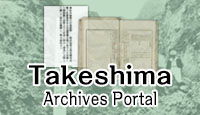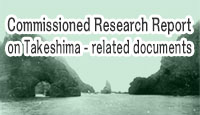The documents and materials published on this website were collected, researched, and prepared with advice from experts, as a part of a Government-commissioned project. The contents of this website do not reflect the views of the Government.
Comprehensive issues
3. Takeshima
In the dispute over Takeshima, South Korea’s alleged “effective control” appears to take the form of “the exercise of many administrative acts and physical management, including stationing security forces, establishing a lighthouse, issuing postage stamps with Takeshima as a design, making maps based on field surveys, conducting academic surveys such as a vegetation survey, having civilian addresses registered, building various structures, constructing wharfs and heliports, etc.”4 These acts, if done in a place over which sovereignty is already established, would be recognized as legitimate under international law. But all those acts were performed after January 18, 1952, when the then President Syngman Rhee issued a “Proclamation of Maritime Sovereignty” and unilaterally drew a “Peace Line” (the so-called “Syngman Rhee Line”) to enclose a vast area of the Sea of Japan, thereby taking Takeshima inside the Line. Moreover, while South Korea’s such series of acts had since continued, Japan has repeatedly protested against not only the “Proclamation of Maritime Sovereignty” but also the illegal possession of Takeshima thereafter and insisted on its invalidity.
In other words, the mentioned acts have been undertaken by the South Korean Government after Japan started claiming the existence of a “dispute.” Although South Korea denies that any “dispute” over Takeshima exists, the definition of “dispute” as seen earlier clearly states: “mere denial of the existence of any dispute does not prove that no dispute exists. (…) Therefore, where there exists a situation (…) involving a clear conflict of views between the Parties (…), the Court must conclude that an international dispute has arisen.” This is certainly what a highly specialized judicial body, the International Court of Justice, says, but common sense also makes it a satisfactory explanation of the matter. Japan has continued to protest against South Korea’s claim since 1952, proposing on three occasions that the case be submitted to the International Court of Justice. As it turned out, South Korea refused to agree to the proposal each time.
In view of these circumstances, it is reasonable to assume that the critical date for the Takeshima dispute is the year 1952, when South Korea declared the so-called “Syngman Rhee Line.” Based upon this reasoning, South Korea’s subsequent series of acts to claim that it has “effectively controlled” the island have failed to constitute legitimate “effective control” in terms of international law. Therefore, it would be inaccurate for the media and the general public to swallow the above-mentioned series of acts by South Korea and describe them as that country’s acts of “effectively controlling” the island.
Note 4
See Tsukamoto Takashi, “Kokusaiho kara mita Takeshima Mondai” (The Takeshima Dispute as viewed from the Perspective of International Law), fifth in a series of lectures on the Takeshima problem delivered at the Shimane Prefectural Library, Assembly Room of Shimane Prefecture on October 26, 2008.
4. Senkaku Islands
China’s recent moves in the South China Sea, even if they are aiming to “effectively control” the region, may be said to be even more groundless. Within a self-styled unilateral enclosure of “nine-dash line” covering a vast sea area, China claims sovereignty over that sea area and says that there is no problem in whatever it may do there. But there is no basis for its claim other than its own assertion that the sea area historically belongs to China, which itself is vague and has a far from convincing legal basis. Indeed, the award of the Philippine/China South China Sea Arbitration (merits) of July 12, 2016 rightly rejected China’s claim. Therefore, it is truly inappropriate for the media and the general public to describe China’s construction of seaports, airports, and other facilities on some islands in the sea area, acting as if it owned them, as “effectively controlling” the area. Such a way of referring to the Chinese acts there could contribute to virtually endorsing and supporting them.
China’s expansion into the waters surrounding the Senkaku Islands is sometimes referred to as an attempt to make a fait accompli of alleged “effective control” over the islands, but this is also wrong. Japan’s ownership of the Senkaku Islands is based on its incorporation of the Islands into Okinawa Prefecture in 1895 and its subsequent “effective control” over the Islands through the continued administrative acts such as leasing and disposing of some of the Islands to the private sector. This has a solid basis under international law. In contrast, China had never raised a voice in protest against such Japanese acts over the three-quarters of a century since Japan’s incorporation of the Senkaku Islands, tacitly recognizing Japan’s sovereignty over the Islands5, and therefore, no “dispute” over the Senkaku Islands exists. In the late 1960s, once the potential of oil and natural gas resources in the waters surrounding the Senkaku Islands was reported, China suddenly began to loudly assert territorial rights to the Islands. In February 1992, most probably in an attempt to show consistency in its assertion, it resorted to a legislation “Law on the Territorial Sea and the Contiguous Zone,” providing in part that the Diaoyu Islands (Chinese name for the Senkaku Islands) is part of its national territory. Based upon that domestic legislative action, China has come to frequently dispatch its Coast Guard patrol vessels to the waters around the Senkaku Islands, allowing them to intrude further into Japan’s territorial waters without permission, even acting violently to interrupt the operations of Japanese fishing boats on the ground that they are invading China’s territorial waters (violation of sovereignty). In this way, it has committed acts far from innocent passage in violation of international law in Japan’s territorial sea. In reporting or commenting on these happenings, the media and commentators tend to say that China is seeking to “effectively control” the Senkaku Islands, but this is a gross misuse of the term and must not pass by unnoticed.
Note 5
Even in the mid-20th century, China was still acting on the premise that Japan owns the Senkaku Islands. See, for example, the People’s Daily of January 8, 1953 with an article using the Japanese name of “Senkaku Islands” alongside “Ryukyu Islands,” etc., and the September 4, 1958 declaration concerning the extension of its territorial sea to 12 nautical miles, listing the names of the islands in its territory with no mention of the “Diaoyu Islands”.
Conclusion
Another key point to note in relation to “effective control” is the importance of maintaining the attitude of refusing to recognize unjustified acts. Failure to do so may result in acquiescence in the other party’s wrong doings. Against South Korea’s actions on Takeshima and China’s actions in the waters surrounding the Senkaku Islands, Japan has repeatedly protested through diplomatic channels at each such time as it thought necessary. Although some find this way of response too mild, acts of protest are valid under international law as a minimum expression of intent, and there has been at least a case where such protests were found valid by an international arbitral tribunal6.
In terms of the acquisition and maintenance or possession of sovereignty and territorial rights over a territory, the most important factor under international law is an objective “effectiveness” of the act in question; when the effectiveness is justified, the ownership of the territory becomes authentic. Therefore, the commonly used phrase “effective control” should be understood as merely representing an “act aiming for virtual (de facto) control.”
Note 6
In the “Chamizal” case arbitration of 1911 over the ownership of a strip of land resulting from the flooding of the Rio Grande on the Mexico-United States border, the U.S. claim of acquisitive prescription was rejected in favor of Mixico’s milder “protests in the form of diplomatic letters” on several occasions by which Mexico avoided any hard-line measures of physical possession in reaction to the U.S. virtual possession of the land in question. Reports of International Arbitral Awards, Vol. 11, p. 329.
Takeshima
Research and Commentary Site
- I Comprehensive issues
- II Commentary on themes by historical period
- III Analysis of claims by other countries





